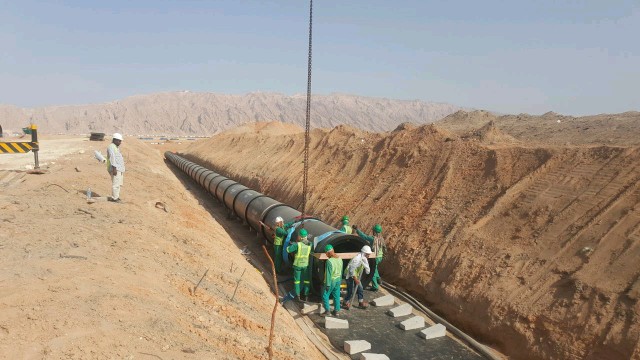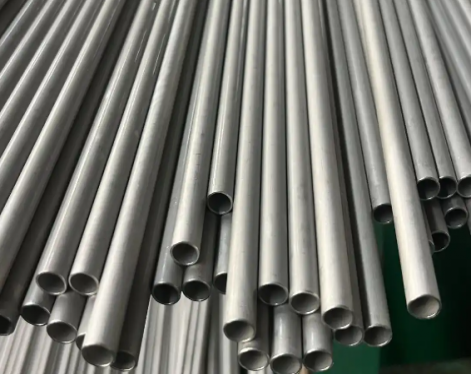Natural gas pipelines refer to pipelines that transport natural gas (including associated gas produced in oil fields) from mining sites or processing plants to urban gas distribution centers or industrial enterprise users, also known as gas pipelines. The use of natural gas pipelines to transport natural gas is a way to transport large quantities of natural gas on land. Natural gas pipelines account for about half of the world's total pipeline length
Pipeline structure
Gas pipelines are assembled by connecting individual pipes one by one. Modern gas gathering pipelines and gas transmission pipelines are made of steel pipes connected by electric welding. There are many kinds of steel pipes, such as seamless pipe, spiral steel pipe (SSAW pipe), and straight seam pipe (LSAW pipe). The seamless pipe is suitable for pipes with a diameter of less than 529 mm, and the spiral seam pipe and straight seam pipe are suitable for large-diameter pipes. The pipe cross-sectional structure of the gathering and transportation pipeline is complicated by inner coating-steel pipe-outer insulation layer-insulation (cold insulation) layer. The simple ones only have the steel pipe and the outer insulation layer, while the inner wall coating and thermal insulation (cold insulation) layer are determined according to the gas transmission process.
Pipeline Features
1) The gas pipeline system is a continuous closed delivery system.
2) From transportation, storage to user use, natural gas is under pressure.
3) Due to the small specific gravity of the natural gas to be transported, the influence of the static pressure head is much smaller than that of the liquid. When the design height difference is less than 200 meters, the static pressure head is negligible, and the line is almost not restricted by the vertical terrain.
4) There is no water hammer hazard in liquid pipelines.
5) When an accident occurs, it is very harmful and affects a wide range. Once the pipeline ruptures, it releases a large amount of energy and has a long tear length, and the discharged natural gas is likely to cause a fire if it encounters an open flame.

Pipeline use classification
Gas transmission pipelines can be divided into three types according to their purposes: gas collection pipelines, gas transmission pipelines, and gas distribution pipelines.
①Gas-gathering pipeline: The pipeline from the gas field wellhead device through the gas-gathering station to the gas treatment plant or the starting compressor station is mainly used to collect untreated natural gas extracted from the formation. Due to the high pressure of the gas well, the pressure of the general gas-gathering pipeline is about 100 kgf/cm2 or more, and the pipe diameter is 50-150 mm.
②Gas transmission pipeline: the pipeline from the gas treatment plant or starting point compressor station of the gas source to the gas distribution center, large-scale users or gas storage depots in major cities. As well as the interconnected pipelines between gas sources, it is the main part of the entire gas transmission system to transport the natural gas that has been processed and meets the pipeline transportation quality standards. The diameter of the gas transmission pipeline is larger than that of the gas collection pipeline and the gas distribution pipeline, and the maximum diameter of the gas transmission pipeline is 1420 mm. Natural gas is transported under pressure at the starting point compressor station and the compressor stations along the route. The gas transmission pressure is 70-80 kgf/cm2, and the total length of the pipeline can reach thousands of kilometers.
③Gas distribution pipeline: the pipeline from the urban pressure regulating metering station to the user's branch line has low pressure, many branches, dense pipe network, and small pipe diameter. In addition to using a large number of steel pipes, low-pressure gas distribution pipelines can also be made of plastic pipes or other materials .
In conclusion
Natural gas pipeline transportation has low cost, less land occupation, fast construction, large oil and gas transportation volume, high safety performance, less transportation loss, and no "three wastes" emissions. It has the advantages of less risk of leakage, less environmental pollution, less impact from bad weather, less equipment maintenance, easy management, and easy remote centralized monitoring.
Pipeline structure
Gas pipelines are assembled by connecting individual pipes one by one. Modern gas gathering pipelines and gas transmission pipelines are made of steel pipes connected by electric welding. There are many kinds of steel pipes, such as seamless pipe, spiral steel pipe (SSAW pipe), and straight seam pipe (LSAW pipe). The seamless pipe is suitable for pipes with a diameter of less than 529 mm, and the spiral seam pipe and straight seam pipe are suitable for large-diameter pipes. The pipe cross-sectional structure of the gathering and transportation pipeline is complicated by inner coating-steel pipe-outer insulation layer-insulation (cold insulation) layer. The simple ones only have the steel pipe and the outer insulation layer, while the inner wall coating and thermal insulation (cold insulation) layer are determined according to the gas transmission process.
Pipeline Features
1) The gas pipeline system is a continuous closed delivery system.
2) From transportation, storage to user use, natural gas is under pressure.
3) Due to the small specific gravity of the natural gas to be transported, the influence of the static pressure head is much smaller than that of the liquid. When the design height difference is less than 200 meters, the static pressure head is negligible, and the line is almost not restricted by the vertical terrain.
4) There is no water hammer hazard in liquid pipelines.
5) When an accident occurs, it is very harmful and affects a wide range. Once the pipeline ruptures, it releases a large amount of energy and has a long tear length, and the discharged natural gas is likely to cause a fire if it encounters an open flame.

Pipeline use classification
Gas transmission pipelines can be divided into three types according to their purposes: gas collection pipelines, gas transmission pipelines, and gas distribution pipelines.
①Gas-gathering pipeline: The pipeline from the gas field wellhead device through the gas-gathering station to the gas treatment plant or the starting compressor station is mainly used to collect untreated natural gas extracted from the formation. Due to the high pressure of the gas well, the pressure of the general gas-gathering pipeline is about 100 kgf/cm2 or more, and the pipe diameter is 50-150 mm.
②Gas transmission pipeline: the pipeline from the gas treatment plant or starting point compressor station of the gas source to the gas distribution center, large-scale users or gas storage depots in major cities. As well as the interconnected pipelines between gas sources, it is the main part of the entire gas transmission system to transport the natural gas that has been processed and meets the pipeline transportation quality standards. The diameter of the gas transmission pipeline is larger than that of the gas collection pipeline and the gas distribution pipeline, and the maximum diameter of the gas transmission pipeline is 1420 mm. Natural gas is transported under pressure at the starting point compressor station and the compressor stations along the route. The gas transmission pressure is 70-80 kgf/cm2, and the total length of the pipeline can reach thousands of kilometers.
③Gas distribution pipeline: the pipeline from the urban pressure regulating metering station to the user's branch line has low pressure, many branches, dense pipe network, and small pipe diameter. In addition to using a large number of steel pipes, low-pressure gas distribution pipelines can also be made of plastic pipes or other materials .
In conclusion
Natural gas pipeline transportation has low cost, less land occupation, fast construction, large oil and gas transportation volume, high safety performance, less transportation loss, and no "three wastes" emissions. It has the advantages of less risk of leakage, less environmental pollution, less impact from bad weather, less equipment maintenance, easy management, and easy remote centralized monitoring.









